
The Development of Xenopus laevis
My Pet African Clawed Frogs and Their Young
Xenopus laevis

The Development of Xenopus laevis
My Pet African Clawed Frogs and Their Young
Xenopus laevis
Click on each thumbnail photograph to see a larger view!
|
From about 1995 on, I have had the male wild-type xenopus pictured below. I originally had five xenopi, but four of the originals have died over the years. They had unique patterns on their backs that made them distinguishable from one another, although I have never named them. There are pictures of the deceased frogs on the Pets of the Past Page. One thing that is interesting about these frogs is that they still possess a lateral line, similar to those found on most fish. The lateral line can be seen in the side view close-up pictures. This area sends messages to the brain about pressure differences and more. These frogs are easy to keep, but are very commonly mis-kept. All they need is a container with water a few inches deep. I also use Am-Quel to eliminate the chlorine, ammonia, and other amines from the water. You should change the water every few days. It should be noted that although many pet stores sell these frogs as "aquarium frogs" and display them in a full aquarium with fish, this is NOT how they are meant to be kept. They breathe air and it can be especially exhausting for a young frog to have to swim to the surface so often to get air. These frogs are meant to lounge around and be pretty still most of the day, occasionally lifting their head to get a breath of air. IMPORTANT: IF YOU HAVE A XENOPUS THAT YOU CAN NO LONGER KEEP, NEVER RELEASE IT INTO THE WILD!!! Many pet stores will accept them back. You might also try this Rescue and Adoption Center. If you let them go outdoors, these frogs will wreak havoc on the environment, eating anything and everything they can fit into their mouths. They can decimate all kinds of wildlife and destroy entire ecosystems. For this reason, xenopus are actually illegal in states with warm climates like California and Nevada because the frogs can survive year-round and are doing major damage to ecosystems when released by ignorant pet-owners trying to do a nice thing for the frog. I hadn't realized this until after I decided to raise the eggs from my pet xenopus. Now knowing that these frogs are such a problem and that there are too many already, I'm not so sure I would have decided to do so.
My male wild-type xenopus Summer 2006 (In the first photo, the living frog is at the bottom left.)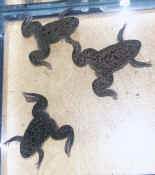  June 15, 2008 with macro lens
June 15, 2008 with macro lens
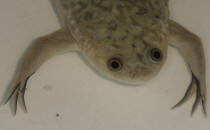
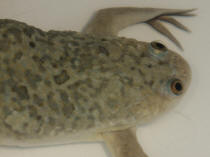
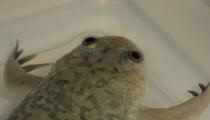
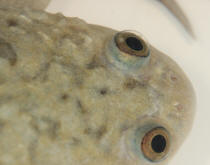
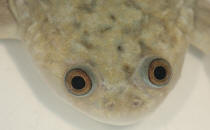
|
The story behind my female albino reticulated xenopus
June 20, 2008 - September 30, 2008
My male frog pictured above was used to having companions in his tank. After his last friend died and he lived a few weeks by himself, he seemed very lonely and I wanted to get him a female. One generally doesn't find good quality adult frogs at a pet store these days (usually they sell the younger ones which are often in bad condition). After some internet research, I found out that one of the largest xenopus distributors, Xenopus One, was right in Dexter, MI, only about 50 minutes away from me. Click here to order your own pet xenopus from Xenopus One. On June 20, 2008, Kelly, one of the owners, met me inside the facility and even gave me a tour around. It was so interesting---I've never seen so many frogs in my entire life! There were frogs from every stage imaginable, from egg to adult. She even showed me her very special frogs that were not for sale. There were some that she called piebalds, which had mostly green patterns, but an occasional blotch of white somewhere---it reminded me of vittiligo. There were also the mutant frogs, with extra limbs. I was glad to know that they weren't for sale and that there were not very many, as other companies actually have these types of frogs regularly for sale on their sites and recommend they be used for dissection and medical studies---they obviously must get a lot more mutant frogs, which although sometimes caused by genetic mutations, can be more likely to occur if water quality and general care is not good while they are developing.
So anyhow, I picked out a reticulated albino female to be my male's new friend. It was "love" at first sight. He grasped right onto her within about five minutes. After a day of mating, he actually shed off his gripping pads (the black areas on what would be like the palms of his hands) from holding on so much. After two days, she laid hundreds of eggs! In all the years I've kept these frogs (about 25), I've never had this happen. Kelly said that although they inject the wild-type frogs with a hormone to cause them to breed, the albinos sometimes will lay eggs on their own. I always had wild-type females before, so maybe that's why this one laid eggs.
The Eggs
The eggs on June 22, 2008. They were not easy to photograph in the water, but you can see how they are composed of a large yellow nucleus surrounded by another clear membrane. At this point, it was necessary to remove them from the water that the frogs were in (or they could have eaten them or kicked them around and broken the membranes). A turkey baster worked especially well for this task. I put them in a separate tub with about 50% original water and 50% new water (with Am-quel added and temperature the same as the original water). It is also important to oxygenate the water with an airpump and airstone from this point on for the best survival rate. A low flow rate is fine because you don't want to swirl up the water so much that the tadpoles can't cling to the sides later on.
Tadpoles --- Day 1
Some tadpoles arrived on June 24, 2008. They were small and white and only about 1/4 inch long. They laid on their sides for the most part. I thought that I had done something wrong and that they were all dying when I first observed this behavior, but apparently, it's just what they do. It was hard to get clear photos through the water (since they were at the very bottom). I did about a 25-35% water change today. I used a turkey baster to separate them out into a new tank (in case the eggs developed a fungus or something).
Tadpoles --- Day 2
On June 25th, one can see how they were becoming more pigmented and their black eyes were more visible. That yellow thing inside their bellies is the yolk sac. At this stage, they were using it for nutrients and did not require any food. In fact, feeding them at this stage can cause them to develop a fungus and kill them. They secrete a sticky substance from their heads from something called a "cement gland" that attaches them to the sides of the tank. They sway with the flow of the water and occasionally become detached and swim off and find another place to latch on. I could get better pictures this time since they were so near the surface. I did about a 25-35% water change today. Some still seem to hang out at the bottom, so I separated those into another tub with the same water mix as the others. I used a turkey baster to very carefully suction out each individual tadpole. I was still finding tadpoles in the egg container as well, which were moved into the bottom-dweller tank.
Tadpoles --- Day 3
On June 26th, one can see that their eyes are becoming more spread out. The yolk sac is also disappearing. They have many more visible spots. I am still maintaining two separate tanks---one with bottom-dwellers and one with side-clingers. At this point, it didn't seem like any more eggs were going to hatch (although there were still hundreds left) and I had plenty of tadpoles, so I discarded the rest of the eggs. I did a 25-35% water change today on both containers. Day 4 was about the same so I didn't take any photos.
Here are the adults today...
Tadpoles --- Day 5
On June 28th, seventy of the 91 tadpoles were free-swimming. They started swimming with their heads down and stopped clinging to the wall completely, not just when disturbed. These were all moved to a larger tub with about 50% new water and 50% old water. At this point, it was necessary to feed them. I used the food obtained at Xenopus One and ground it up in a small food chopper/blender with a lot of water. I then poured only the water broth in. As they develop more, they should be able to eat more of the other finely ground material, but for now, it would only decompose at the bottom of the tank. The remaining bottom-dwellers were still maintained in their own separate tank and got about a 25-35% water change today.
Tadpoles --- Day 6
On June 29th, all but six of the 91 tadpoles were free-swimming. I used the turkey baster to suction out the debris at the bottom (along with a good amount of water). I think it ended up being about a 30-40% water change. I noticed there is one tadpole with a slightly twisted spine who was not getting as much food as the others (you can see their stomachs since they are transparent), so I put that one in with the others that were not completely free-swimming and just put in a small amount of food in that tank). I am still surprised that all the original tadpoles I started with are still alive!
Here are the adults today...
Tadpoles --- Day 8
By July 1st, the tadpole with the twisted spine and two of the smaller ones had died. So I decided to put the other two remaining free-swimming smaller tadpoles in with the others. They seemed to be holding up fine. At this point, the tadpoles are about 1/2 inch long. I am feeding them twice a day, about enough food broth for them to make the water clear again in about two hours. The first two photos show the different size of the smaller ones and a close-up of it.
Tadpoles --- Day 10
On July 3rd, one of the smaller tadpoles had died along with a lighter-colored one of the larger ones. I decided to remove the other small one and put it in a separate tank. I have a few tadpoles that are almost an inch long now. It is getting much more difficult to photograph them because they are almost constantly in motion. Their hearts are clearly visible and one can see them pumping blood through the chambers. If you look carefully, you can see the heart in the second photo. A few are beginning to develop barbs near their nostrils, like a catfish would have. One can also see how their eyes are beginning to take the shape of a frog's eyes.
Also on this day, I decided to separate the male and female adult frogs. He has been latched onto her nearly 24-7. She was turning slightly purple (perhaps from not getting to breathe enough?), so I took him out and she looks much better. She has laid 3 more substantial batches of eggs (100-200) and one tiny batch of about 50 eggs that looked comparatively small and were rather greenish instead of yellow. I threw them all away because I have my hands full with the tadpoles I already have.
Tadpoles --- Day 13
Here are the tadpoles on July 6th. They are doing well and there haven't been any deaths in the past three days. There is still one teeny-tiny tadpole that is just not developing. I have been keeping it in its own tank. It looks like a day 3 tadpole.
Tadpoles --- Day 19
Here are the tadpoles on July 12th. They look about the same as six days ago, only larger. A few are nearly 2 inches long. The teeny-tiny tadpole died today. It still only looked like a 3-day tadpole. Something in its genetics must not have kicked in to make it develop properly. It looked like its stomach was empty even though I'd been putting food in for it. On Day 14, I transferred all the tadpoles to a bucket using a cup to scoop them. I counted 83, so maybe there were a couple deaths along the way that I somehow didn't notice. After the transfer, I cleaned their container, which had begun to develop a slimy coating on the walls and floor. This whole time, I have been feeding them about every 12 hours. This seems to work well. None seem too aggressive and they are not picking on anyone yet. They are much harder to photograph though because of their speed. In the fourth photo, one can actually see the two halves of the brain and the cerebellum as well as part of the attached spinal cord.
Tadpoles --- Day 25
Here are the tadpoles on July 18th. Most of them have very small hind legs forming. A few of the tadpoles that are more developed are actually flexing their legs, instead of just swimming around with them loosely flopping at their sides. One sad thing happened on day 21. All in one night, about 15 of the tadpoles had developed crooked tails. Some had bends in a couple places. I separated them out and started reading about possible causes. In case it was a calcium deficiency, I started putting a few pinches of calcium dust (like you'd put on crickets) in with their food mix to be safe. However, a few days later, about another 15 had also become bent. I haven't done an exact count yet. I have read many studies about these things happening when there are certain chemicals in the water. It leaves me wondering what is in the Detroit water. For one, it is way too costly to be testing the water for contaminants, especially not every one. They do some testing that comes out in the published water report, and even those allow for some pesticides and other awful things to be in the water in small concentrations (whatever that means). Still, those tests aren't done every day. With everyone hurting for money, I wouldn't doubt it if people are dumping things into our water supply to save money on proper waste disposal. I know I have been doing everything right with these tadpoles. I would have used distilled water except that everything I read said not to because it wouldn't have the proper salts and minerals in it. Everything was fine up until that one day. It seems to me that if I were doing something wrong, this would be a more gradual mutation. There were tadpoles in all growth stages affected by this too. Anyhow, I feel bad for the tadpoles, and I wonder what's in my water.
I decided to put the adults back together again. They seemed lonely. Here they are on July 19, 2008. He is not trying to mate with her continuously like he was before. He seems to have mellowed out some. He's totally got it wrong here...
Tadpoles --- Day 30
On July 23rd, thirty-one tadpoles had their front legs. The other fifty-two did not. I separated out the ones who had front legs, so the pictures below contain some mutant tadpoles (with crooked tails) and some normal ones. The first and second photos show tadpoles with front limb buds (the stage before they get their toes).
Tadpoles --- Day 34
Here are the tadpoles on July 27th. Many are starting to look more like frogs in that their head is changing shape and getting smaller. They are also starting to get some spots and patterns on their backs.
"Frog-poles" --- Day 37
Here are the tadpoles (nearly froglets) on July 30th. Their tails are rapidly being absorbed and they have the shape of an adult xenopus. By Day 35, only four of the eighty-three tadpoles did not have front legs.
Froglets --- Day 40
By August 2, 2008, only two tadpoles are still using their gills. The rest look like tiny frogs.
Frogs --- Day 56
By August 18, they all look like little frogs. Their skin patterns are starting to show. They have been eating tiny solid pellet food called HBH Frog and Tadpole Bites. The best thing is that they are so much less work. They don't mess up the water for several days, so I no longer have to do water changes twice a day. Still, this is one reason I'm looking forward to school starting---giving these frogs away! It has been a fun and interesting experience, but one that I will most likely never do again. It is a lot of work and as I said earlier, there are many of these frogs that need homes already.
This time, instead of photos, here is a movie of the baby frogs feeding.
Frogs --- Day 87
Here are two videos of the frogs on September 18, 2008. They are now finding new homes with my students at school. It seems I will have no trouble adopting them out. While it is sad to see them go, I am glad that they will be bringing joy to many others.
Death of Mama Xenopus
For no apparent reason, I found the female upside down and dead in her tank on September 30, 2008. I only had her a little over three months. I just saw her that morning and fed her the night before and everything seemed normal. The male seems fine except for the fact that he wouldn't eat for several days and is acting depressed again. I am hoping his babies will grow up soon so that I can put them in his tank to keep him company. Right now, I'm still afraid he could eat them.
Daddy Meets His Babies
Daddy seemed very lonely and sad, so on October 5, 2008, I put him with four of his children. They seemed very happy and so did he. The babies really enjoy hiding out underneath him. Over about a month, these frogs actually grew almost twice as large as their brothers and sisters who were kept separate from their dad. He must be secreting some kind of growth hormone into the water. I only took one photo from the 5th with him and one baby. The other five photos are from the 17th.
Babies' sexes determined
As of February 2009 (about 7 months after hatching from the eggs), the babies that were going to be males developed their mating pads on the "palms" of their "hands". Out of the 14 frogs I currently have left, only two are males. One resides with Daddy and four of its sisters. The other lives with three sisters. Another five sisters live together in another container. The photos below were taken on March 15, 2009.
Daddy and his roommates:
Here is a video of Daddy and his babies swimming around...
Brother and Three Sisters
The photos below were taken on March 15, 2009. On June 5, 2009, I found 2 of these frogs dead in their tank with some sort of brownish fungus-like material on them. I took the remaining two out, which was the one in the upper left in the first photo and the one in the lower right in that same photo. Within about a half hour, the one on the left had also died. This was especially sad because these were the frogs I had hand-selected for their special patterns. I do not have any frogs that are anything even similar to these. The three that died were my favorite of the four. You can see these three together in the smaller photo in the middle in the second row.
"Twista" the Twisting, Turning, Twirling Clawed Frog
Since Twista was a tadpole, she was always swimming all over the place, completely off-balance. I thought surely this tadpole would die before becoming a frog. However, she didn't, and as a frog, she exhibits this same twisting, turning, twirling behavior. I have never seen anything like it. She lives happily with her daddy, brother and sisters. One can usually pick her out right away because her normal resting position is sideways on her left hind foot. Here is a video of Twista doing her thing...
Daddy's Son Tries to Mate with Him
On June 10, 2009, I found the only other male I have (now that one of them died with the frogs pictured above) embracing Daddy in a mating grip...
Daddy Mates with his Daughter
On June 12, 2009, I caught Daddy mating with his daughter. I'm not sure who was making the strange clicking sounds, but I'm assuming it was either him or the other male frog. All know is that in 26 years of keeping this type of frog, I have never heard anything like this---it sounds nothing like their usual underwater croak.
Here are some photos of them on the same day...
Here is a photo of them on June 22, 2009.
"Twista" the Twisting, Turning, Twirling Clawed Frog in the fall of 2009
Here is Twista eating food sticks with daddy and siblings on 9-22-09...
Here is Twista in the position I found her when I arrived home from work on October 9, 2009. She rests like this often. It must be comfortable to her, although it looks quite contorted compared to a normal frog's resting position.
Here is a quick shot of Twista on January 4, 2010 as she swims in her sideways fashion.
"Twista" the Twisting, Turning, Twirling Clawed Frog in 2010
Here she is twirling for joy on St. Patrick's Day...
[ Lyle Sundog Gordon ] [ Darwin, the Amazing Border Collie ] [ Dogs of the Past ]
[ Don the Spadefoot ] [ Frank the Spadefoot ] [ Other Spadefoots ]
[ Twista the Dancing Clawed Frog ] [ African Clawed Frog Development ]
[ Pet Toads ] [ Wild Detroit Toads ] [ Wild Metro-Detroit Toads ]
[ Bunny Boy ] [ Beatrice the Mallard Duck ] [ Caring for Abandoned Sparrow ]
[ Past Fish and Other Pets of the Past ] [ Pepper Loach ] [ Box Tortoises ]
[ Biglegs the Jumping Spider ] [ Tufts and Mr. Greenfangs ] [ Radinka the Platycryptus undatus ] [ Caring for Jumping Spiders ]
[ Home ] [ Artwork ] [ Photography ] [ Art Cars ] [ Virtual Museum ] [ Pets ] [ Favorite Links ] [ What's New / My Blog ] [ Guestbook ] [ For Sale ]
Copyright © 2004-2024 kozmicdreams.com. All rights reserved.
All materials contained on this site, including text, graphics and icons, are the property of
kozmicdreams.com.